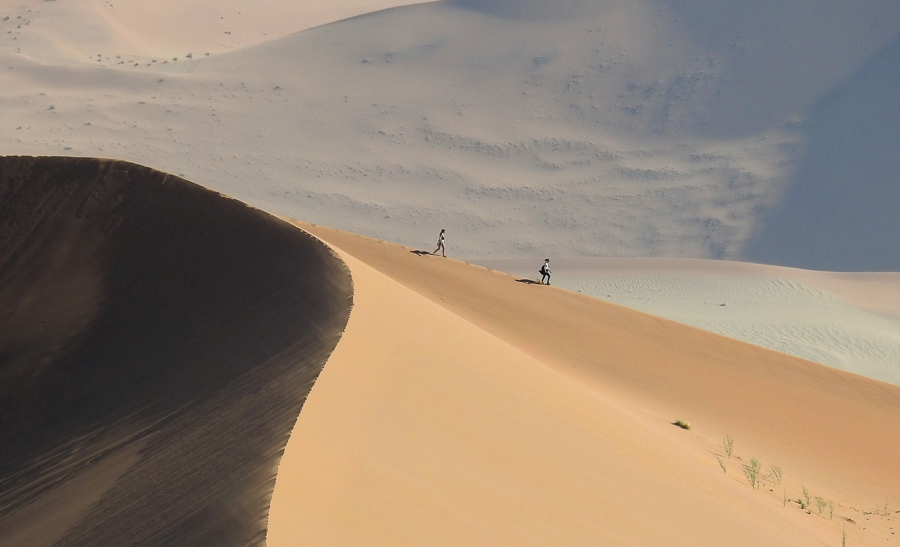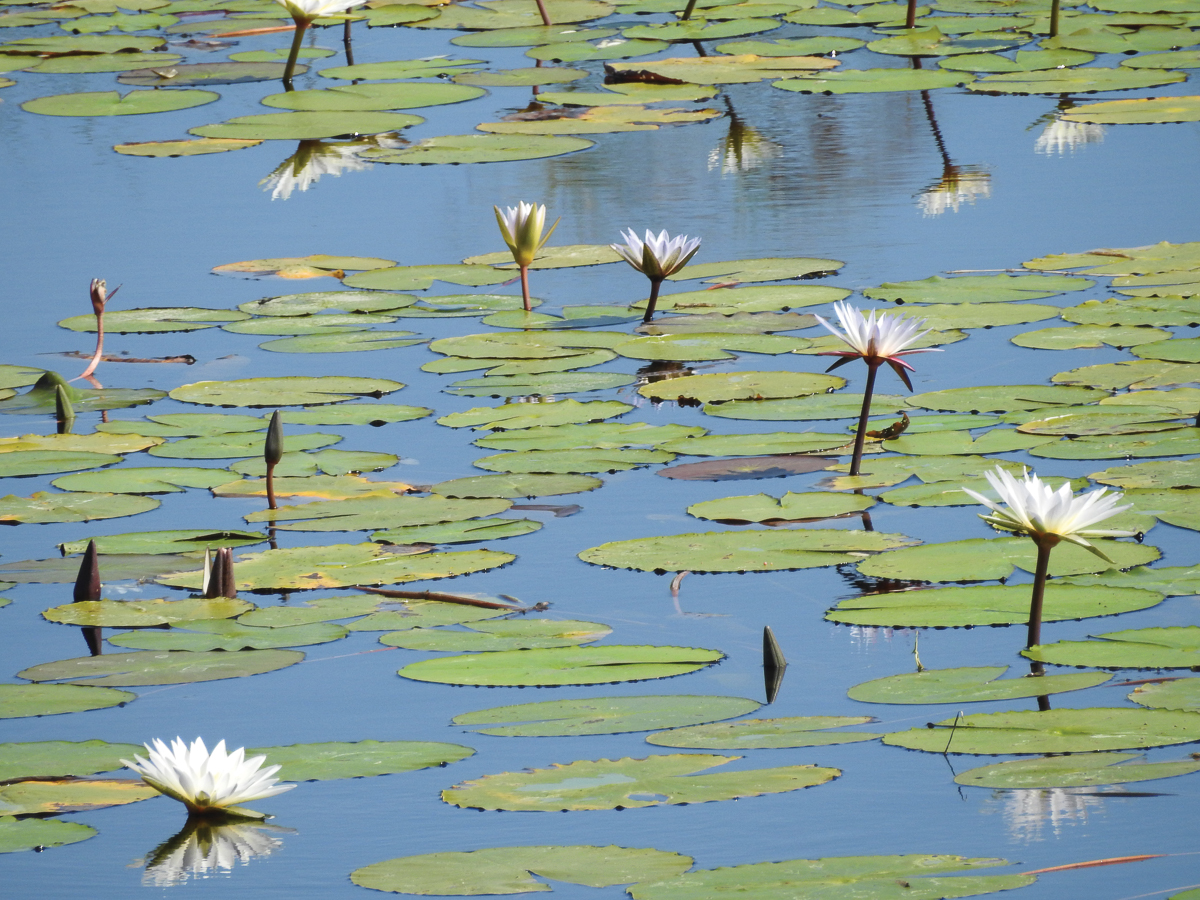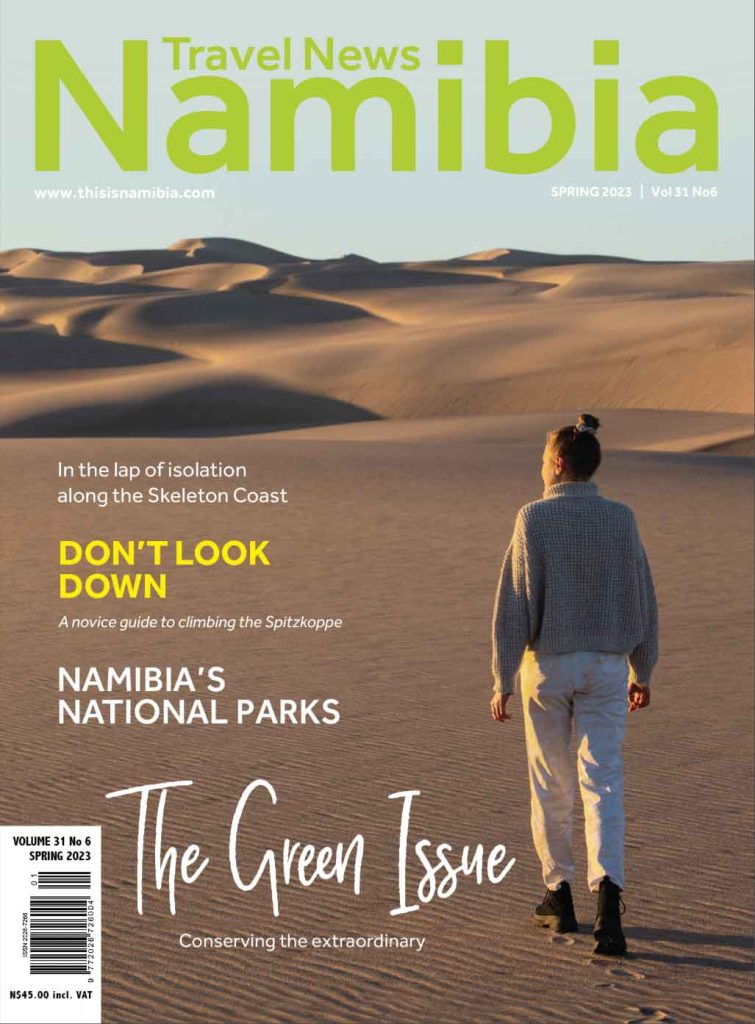

7000km across Namibia
For his 60th birthday, Iga Motylska took her father on a month-long, 7000 km road trip around Namibia. Their tyre tracks stretched from the Zambezi Region to the Orange River and at times saw them sleeping in the back of his converted Landy.
Text & Photographs Iga Motylska
From the Spring 2023 issue
Bound by sand
Despite what your English high school teacher might have told you, not every story begins at the very beginning. Particularly not this one. This one begins slap-bang in the middle of our month-long, 7000 km, father-daughter road trip across Namibia. It also begins on the side of a gravel road somewhere in Skeleton Coast National Park.
I am squinting into the distance, trying to make out whether that is the Atlantic swimming on the edge of the Earth. It is only later, as we get closer, that I realise it is a misty mirage of ocean air mingling with a dehydrated desert draft to create a condensation swirl that hangs heavy on the horizon.
My father is cranking the car jack. This is the second tyre we are changing in less than a week. And when I say ‘we’, I mean ‘he’ because his MacGyver-like resourcefulness would definitely see him picked first in Survivor. I know the drill by now and prop three large rocks against the remaining tyres. And although I ask a number of times if there is anything I can do to make myself useful, my work here is done. Instead, I resort to looking out for the desert-adapted lions that the sign at the gate warned us about. You would think they’d be easy enough to distinguish against the barren landscape (should they happen to be within our vicinity in the 17 000 km2 park), but alas, we are not that lucky.
Before you judge me too harshly, he is in charge of navigating and all things car-related, while I have taken the wheel in planning our cross-country trek down to a T, with enough flexibility for spontaneous detours – and the occasional tyre change.
It is tradition that I treat tatuś (the diminutive form of ‘father’ in Polish) – to an annual birthday trip. And the big 6-0 had to surpass our previous trips. Though top of his list, Namibia had always eluded him. We traced an itinerary onto a map a number of times, but somehow responsibilities elbowed their way into reality. For all those times we said we would, but didn’t, this time we went all out.
The plan was to explore as much of Namibia as time would allow. As we hopscotched around the country, we learned fairly early into our trip that distances in Namibia are measured in time rather than kilometres. Our tyre tracks stretched from the Zambezi Region to the Orange River. Our adventure saw us stay in some of the country’s most luxurious lodges, in family-run guesthouses in the-middle-of-nowhere, a hostel and at camp sites in the back of his converted Landy with our supplies ‘Jenga-ed’ on the roof rack.

On the road
Tatuś drove his trusty Land Rover Discovery 4 to Namibia from Johannesburg via Botswana, while I flew into Hosea Kutako International Airport from Cape Town. The following days were spent indulging in eco-conscious experiences at Habitas Namibia.
Once rejuvenated, Windhoek was our springboard into the waterscapes of the Zambezi Region. Shortly after our FlyNamibia flight to Katima Mulilo, we floated along sections of the 450-km panhandle amidst wetlands and marshes in search of game and birds. For those few days, life revolved around water, offering a stark contrast to what many believe Namibia to be.
Back in the capital, we made a beeline towards Spitzkoppe’s granite peaks, arch-like Bridge and San rock art – home to the most spectacular camp site location we have stayed at. The White Lady welcomed us to Brandberg and pointed us in the direction of the Organ Pipes and one of the largest collections of petroglyphs in Africa at the Twyfelfontein UNESCO World Heritage Site.
During our stay at Wilderness Desert Rhino Camp in the Palmwag Concession, we had the privilege of tracking the world’s largest population of free-roaming desert-adapted rhinos – alongside members of Save The Rhino Trust, who protect the 25 000 km2 concession. Next, a photographic safari took us along the Huab River Valley in Damaraland to watch a herd of desert-dwelling elephants saunter towards the next waterpoint.
And that was when our eventful introduction to the Skeleton Coast started. We conjured optical illusions on the salt flats, explored the abandoned mining sites and were humbled by nature’s might at the sight of the remains of countless ill-fated ships.
Then the coastal road spat us out in Namibia’s playground, where our day began with a flight with Hot Air Ballooning Namibia as the sun bathed the Rössing Mountains in morning light. Our days in Swakopmund were filled with sandboarding, fat-tyre e-biking along dune crests and living desert tours in search of lesser-seen critters.
Next, we hopped, skipped and jumped from Walvis Bay to the apple-pie capital of Solitaire and onwards to Namib-Naukluft National Park. Photographs cannot convey the dimensions of the star-shaped dunes at Sossusvlei. It was only as we were standing before them that we wondered how the heck one scrambles to the 360-metre summit of Big Daddy. From atop the world’s highest sand dune, camelthorn skeletons danced with the sun across the white clay of Deadvlei. We bade the day farewell during a 45-minute sunset flight over the desertscape. Without him having to tell me, my father’s highlight was sitting next to the Desert Air pilot in our Cessna 210.
The sky at NamibRand Nature Reserve unfurled to reveal why it is Africa’s first (and one of only two) Dark Sky Nature Reserves. The minimal light pollution in these remote parts make it an enviable location for astro-tourism. It was tatuś who woke before 4 am to witness the lunar eclipse with an astronomer at the nearby &Beyond Sossusvlei Desert Lodge in their observatory.
We were told to have our cameras at the ready as the C13 to Aus is said to be one of Namibia’s most scenic roads. Aus spoiled us with multiple sightings of the wild horses of the Namib, though we failed to find any alluvial diamonds at Kolmanskop ghost town. Instead we cheered our wealth of experiences with Lüderitz oysters washed down with a Hansa.
Long after returning to Cape Town, I was still shaking sand from my shoes – a reminder that I took home grains of sand from the world’s oldest desert. They have been fashioned from rock in slow motion, with nature as the artist that has shaped the land into an ever-changing, abstract sculpture.
How to stretch your budget
Book the DBB option: Consider booking a dinner, bed and breakfast (DBB) package, especially in remote areas where dining options are scarce.
Loyalty pays off: When booking multiple stays across the country with the same travel partner, ask about discounts, rewards and loyalty benefits.
Home sweet home: Renting a home on the Atlantic coastline is often more affordable and spacious than a hotel.
The whole package: DMCs offer set or tailor-made itineraries to suit your budget, travel style and interests, often at a more affordable cost than what independent travellers might find.
Rent a car: For groups, renting a car is a cost-effective alternative to taking (or chartering) a flight. A reliable 4×4 with air-conditioning is recommended. Book as soon as your travel plans are confirmed as the limited number of rentals disappear quickly during peak season.
Shuttle: McClunes Shuttle Service runs daily shuttles from Windhoek to Swakopmund and Walvis Bay.
If you don’t have a month?
FlyNamibia has daily Safari Circuit flights that connect Windhoek to Sossusvlei and Etosha National Park, with onward flights from Sossusvlei to Swakopmund. The airline operates weekly flights to Ondangwa, Rundu, Katima Mulilo, Lüderitz and Oranjemund. Domestic and chartered flights depart from Eros Airport in Windhoek.
Driving in Namibia
Resources: The ‘DriveNam’ Facebook Group is an invaluable online community where you can ask about the best, quickest, most picturesque driving routes. It posts updates about border crossings and driving permits.Download the Maps.me smartphone app for offline maps.
Check roads: Gravel roads are tricky to navigate and brakes respond differently to how they do on tarred roads. Before setting off, inquire about road conditions, especially after the seasonal rains. Certain parts of the Zambezi Region may only be accessible by boat during this time.
Avoid driving at night: Outside the main towns, roads are unlit and run through unfenced wildlife corridors, where nocturnal animals roam freely. You also don’t want to break down in ‘the middle of nowhere’ after sundown.
Stick to marked roads: While Namibia’s landscapes may seem desolate and uninhabited, cars damage these delicate ecosystems, hamper rehabilitation efforts and leave scars for hundreds of years. Protect the environment by sticking to marked roads.
Come prepared: Pack spare tyres and repair kits, sufficient drinking water and extra fuel, especially during peak season when remote petrol stations may temporarily run out of fuel. In distant locations petrol stations are few and far between, so it is best to fill your tank and jerry can whenever possible. Some of them only accept cash. Don’t forget to pack your padkos.






